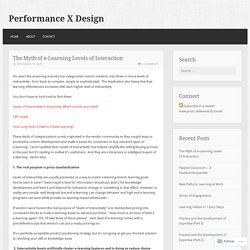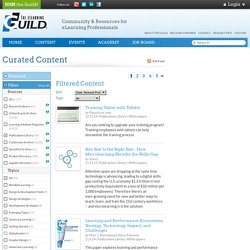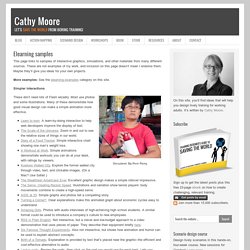

The Myth of e-Learning Levels of Interaction – Performance X Design. For years the eLearning industry has categorized custom solutions into three or more levels of interactivity– from basic to complex, simple to sophisticated.

The implication also being that that learning effectiveness increases with each higher level of interactivity. Interactivity in e-Learning – Do you need to go up a level? Interactive Elements in E-Learning. We’ve all seen it…the “page-turner” style e-learning module that shows you slide after slide of text.

Sometimes the text may even be accompanied by a picture or some audio. Whatever the content, you find yourself hitting the “next” arrow as quickly as possible to avoid falling asleep entirely. Before entering the training and development field, I can tell you that this was something I had come to expect when I sat down for on-the-job training.
However, I can see now that most instructional designers in the field are transitioning away from using a series of PowerPoint slides with bullet points and trying to find ways to add a level of interactivity to their learning solutions. CBT and WBT Levels: A Discussion to Help Determine the Cost of eLearning. By Erik Lord Download PDF (348KB) Classifying the level of training is a flexible metric.

It is important to have a general framework for such levels, however, so both the project sponsor and the developer have a standard reference point to ensure scope and requirements are aligned. For example, when a company requests a bid on an eLearning project, everyone should have the same point of reference to determine what is being requested – resulting in pricing that is accurate and comparable. We therefore need fairly strict definitions of what the levels are, or else they are not of any practical value. As applied to eLearning, such classifications are impacted by general complexity, range and richness of multimedia, and – perhaps most dramatically – the depth of interactivity.
Interestingly, the actual levels defined within this class are somewhat arbitrary. Level 1: Level 2: Level 3: Those three levels generally suffice as general guidelines, but variations are easily configured. Designing For Bite-sized Learning. After identifying a training need, learning designers often think of the solution as a “program”—the classroom experience, the online courses, and the Learning Management System to organize it all.

While robust programs might be best for certain projects, leaving out the in-between “snack times” could mean missed opportunities to engage and reinforce learning. Microlearning, also called “bite-sized learning,” is great strategy for helping learners solve real problems or keeping the them connected to the topic long-term. Bite-sized learning was the topic at our February 2015 Collaborative Learning Network session. As always, the versatile professionals from a mix of industries—healthcare, creative agencies, government programs, and education—helped the topic come alive.
We spent 90 minutes defining microlearning, looking at examples, and sharing our own experiences with it as learners and designers. The sessions aren’t meant to be presentations. What is the cost of an eLearning course? - Infographic. What’s your business goal? If you haven’t seen the Action Mapping overview, check it out now.

If you skip it, much of the blueprint won’t make sense. The strongest projects are designed to change business performance. The business goal is the reason the elearning exists. A clear, specific business goal: Helps you identify the crucial content Helps you design realistic, hands-on activities Motivates learners Shows that you have a measurable impact on your company. Curated Content. Research Library Guild Research delivers four specific types of research reports whose single goal is helping you make sense of the depth of our field.

We work with great thinkers to analyze existing and new sources of knowledge and bring you concise reports that you can use to make important decisions, inform practice, and keep up-to-date. This is where you will find out about research in the field, new technologies, and what your peers are doing and thinking, in practical language. More Info > Online Events Archive The Online Events Archive provides on-demand access to recordings of all online events produced by The eLearning Guild since early 2003, including Online Forums, Thought Leaders Webinars, "Best of" Webinars, and sessions from other online conferences the Guild has hosted.
More Info > Learning Solutions Magazine More Info > Publications Library More Info > Conference Archive. The eLearning Guild: Community & Resources for eLearning Professionals. E-learning & Multimedia Journalism Examples. Infographics, simulations, and online courses. This page links to samples of interactive graphics, simulations, and other materials from many different sources.

These are not examples of my work, and inclusion on this page doesn’t mean I endorse them. Maybe they’ll give you ideas for your own projects. More examples: See the elearning examples category on this site. Simpler interactions Storyplanet: Big River Rising These don’t need lots of Flash wizadry. More advanced interactions Blood Typing Game from Nobelprize.org The samples below include more complex navigation or sophisticated animation.Blood typing game. Choose a Different Ending from droptheweapons.org. Kern Type, the kerning game. Manifesto for learning & development professionals.